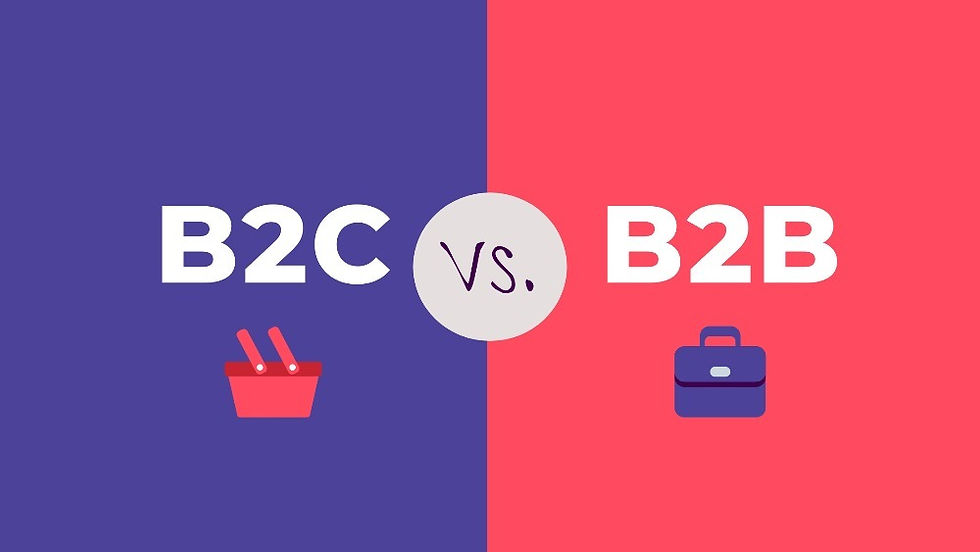B2C vs. B2B fintech marketing
- Editor

- Jul 8, 2020
- 3 min read
Updated: Apr 14, 2021
What is the difference between B2C and B2B marketing in fintech? Amandine Moreau, VP of Marketing at the fintech scaleup iBanFirst, outlines the 4 major factors distinguishing the two strategies and explains why marketing and sales alignment, and personalisation are key to developing an effective fintech marketing growth strategy.

What are the differences between B2C and B2B fintech marketing?
There are quite a few differences between the two strategies, but if I had to summarise them, I would focus on the following 4 key types:
Targeting scope and personalisation
First and foremost, the size of the target market in B2B is generally much smaller than in B2C which requires much greater personalisation. While in B2C a generic message can be sent to a large target audience, in B2B personalisation is key and the more personalised, segmented and relevant your marketing is, the better chances you have of attracting and converting the right prospects and consumers. And when we talk about personalisation, we don't only mean a person's name, position or company, but also his/her specific pain points, interests and needs.
At iBanFirst, for example, where we offer a technological solution that revolutionises companies’ foreign currency payments, we had to perfectly understand the stakes and needs of a CFO versus those of a corporate treasurer in order to build an effective marketing strategy. This degree of customisation requires the strongest possible dialogue between marketing and sales teams.
Channels
While certain outreach channels, such as paid search (SEA) or display advertising, seem absolutely essential in B2C, they are much less so in B2B, where interpersonal relations are key. Tele- and event marketing strategies, on the other hand, seem to be working particularly well in B2B, especially when combined with a well-targeted content strategy.
Complex decision-making process and long buying cycle
While consumers often follow their emotional impulses and are bound by the constraints of their wallets, a B2B purchase decision is the result of a much more rational thought process. In B2B marketing, you need to be more proactive in providing statistics and figures, and indicate the potential savings in terms of time, money or human resources, while preparing for much longer closing times than in B2C.
In addition, where the success of a B2C marketing campaign can generally be evaluated quite quickly, it can take several months in B2B. This can sometimes mean proceeding with a new campaign without experiencing the success of the previous one, which can be frustrating! There is also the added complexity of allocating leads to specific campaigns, as there may be several decision makers within a single company.
Lead acquisition limitations
Last but not least, it is almost impossible to engage in commercial offers, bonuses and incentive programmes in most B2B marketing models, as we’re not operating within the personal sphere of our target. Though it may seem paradoxical, very often, B2B prospects may even feel uncomfortable with bonuses and offers of this kind.
Why having a cross-functional team is important for developing an effective fintech marketing growth strategy?
This is due to the prevalent logic of vertical integration, whereby each department will unleash its strengths at the most opportune moment or stage of the marketing conversion funnel. This broadly consists of a "one-to-many" approach for marketing and a "one-to-one" approach for sales, with very strong personalisation elements throughout this process.
To put this into perspective, the marketing department will personalise its email marketing campaign by taking into account the challenges their target prospect is up against. The sales representative will subsequently respond to the prospect with a tailor-made offer. In this kind of acquisition process, the feedback loop is essential in order to measure or adapt campaign performance in real time.
What is the biggest marketing challenge you currently face at iBanFirst?
We are currently facing many challenges, especially with the recent changes in the global business environment and the major shift to remote working. Our number one priority though is to increase lead generation via a robust and, above all, scalable marketing infrastructure. Secondly, we are aiming to replicate this model internationally. In our case, this means the juxtaposition of national markets with the development of a global reputation.

About Amandine Moreau: Amandine Moreau is a VP of Marketing at the Belgium-based fintech scaleup iBanFirst. She has more than 10 years of experience in fintech marketing and has worked with global market leaders such as Saxo Bank and American Express.




Comments